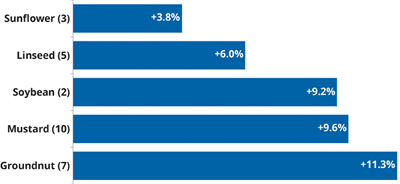Impact on Indian Agricultural Production
In view of the fact that now S deficiencies are wide spread, their impact on agricultural production cannot be ignored. Any deficient nutrient will hold back the performance of all other nutrients even if they are not limiting.
Sulphur and Crop Yields
While soil tests for sulphur deficiency indicate the likelihood that a crop grown on that soil will benefit from or respond to sulphur application, the real proof is when on such soils, sulphur application actually increases crop yield in India.
The following table summarizes research findings on the impact of sulphur on yields of cereals, pulses and oilseeds under field conditions in different parts of India.
Crop |
Studies averaged* | Mean application rate, kg S/ha |
Response to S, kg grain/kg S |
| Wheat | 35 | 39 | 19 |
| Rice (Paddy) | 23 | 42 | 16.6 |
| Chickpea | 6 | 85 | 5.3 |
| Pigeonpea | 8 | 36 | 8.9 |
| Blackgram | 9 | 30 | 5.4 |
| Greengram | 6 | 40 | 3.3 |
| Groundnut | 29 | 34 | 13.3 (pods) |
| Mustard | 29 | 43 | 7.7 |
| Sunflower | 10 | 24 | 13 |
| Soybean | 8 | 36 | 9.4 |
| Linseed | 5 | 26 | 9.5 |
In other words, sulphur applications on sulphur deficient soils increased crop yield by:
| 32% in Groundnut | 25% in Soybean | 20% in Sunflower |
| 30% in Mustard | 22% in Pigeonpea | 17% in Rice |
| 25% in Wheat | 20% in Greengram | 16% in Linseed |
Such response rates are significant, comparable to those obtained from other major nutrients and are highly profitable.
Sulphur and Crop Quality
Sulphur improves crop quality in many ways:
- Increasing the oil content of seeds.
- Increasing protein percentage in plants and harvested produce.
- Improving nutritional quality of forages by providing a balanced N:S ratio.
- Improving starch content of tubers.
- Improving baking quality of wheat.
- Increasing sugar recovery in sugarcane.
- Enhancing marketability of copra (coconut kernel).
In India, sulphur is most frequently identified with improvement in oil content of oilseed crops. In fact, each kg of sulphur applied can increase the supply of edible oil by 3.0-3.5 kg. The production of oilseeds is much below the requirement, a gap which sulphur fertilization can help to fill. Some estimates of increase in oil content of oilseeds are provided in the figure below.

Figures in parenthesis indicate number of studies averaged. Apart from field crops, results from Tocklai Tea Experiment Station, Jorhat, Assam show the beneficial effect of S on improving tea quality. Application of 20 kg S/ha improved tea quality rating from 61.0 to 74.0 (+ 21%).
Sulphur and Economic Returns from its Use
Not widely appreciated is the fact that sulphur today is least costly of the four major nutrients (N, P, K, S). This means that:
- Sulphur application is highly profitable.
- At similar response, profits from sulphur are higher than from other nutrients.
- Being least expensive, sulphur has lowest break-even point using N, P and K prices based on FAI's Fertiliser Statistics.
- Lower response rate needed in case of sulphur for an acceptable value:cost ratios (VCR) of 2.5.
| Nutrient | Retail value, Rs/kg | Kg grain (Rs 6/kg) needed to pay for 1 kg nutrient |
| N (as Urea) | 10.00 | 1.67 |
| P2O5 (as DAP) | 15.43 | 2.57 |
| K2O (as MOP) | 7.01 | 1.17 |
| S (assumed average) | 5.00 | 0.83 |
It costs less than 1 kg of cereals and even less than 0.5 kg of pulses/oilseeds to pay for 1 kg of sulphur. Based on average response rates, the VCR as a result of sulphur application are very attractive, ranging from 8 to 34 as shown below:
- Sunflower (34)
- Groundnut (34)
- Wheat (25)
- Pigeonpea (21)
- Mustard (19)
- Paddy (18)
- Soybean (17)
- Blackgram (13)
- Chickpea (12)
- Greengram (8)
Sulphur and Fertilizer Use Efficiency
Sulphur interaction both synergistically and antagonistically with other nutrients. In most cases, sulphur acts synergistically with nitrogen, the most often applied nutrient. Both nitrogen and sulphur improve each other's efficiency and their combined impact on yield and nutrient recovery by crops is bigger than the sum of their individual effects. The nature of interactions between sulphur and phosphorus depends on the rate of application which is a reflection of whether the two nutrients are balanced. The interaction of sulphur with magnesium and boron can be positive or negative but in the case of oil crops, it is more clearly evident in oil yield than in seed yield. Out of the total response of groundnut to S and B application, the synergistic effect contributed 22% to the increase in kernel yield but 43% to the increase in oil yield.